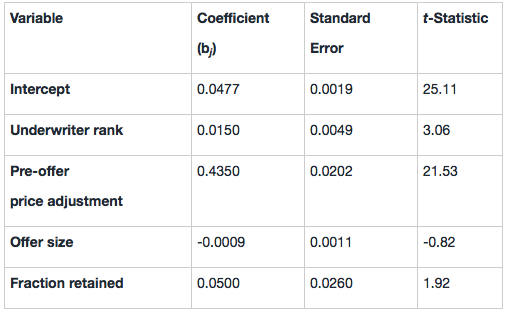NO.PZ2015120204000015
问题如下:
Based on past research, Hansen selects the following independent variables to predict IPO initial returns:
Underwriter rank = 1–10, where 10 is highest rank
Pre-offer price adjustment (Expressed as a decimal) = (Offer price – Initial filing price)/Initial filing price
Offer size ($ millions) = Shares sold × Offer price
Fraction retained (Expressed as a decimal) = Fraction of total company shares retained by insiders
He also believes that for each 1 percent increase in pre-offer price adjustment, the initial return will increase by less than 0.5 percent, holding other variables constant. Hansen wishes to test this hypothesis at the 0.05 level of significance.
Hansen collects a sample of 1,725 recent IPOs for his regression model.
\Hansen’s Regression Results Dependent Variable: IPO Initial Return (Expressed in Decimal Form, i.e., 1% = 0.01)

Selected Values for the t-Distribution (df = ∞)

The most appropriate null hypothesis and the most appropriate conclusion regarding Hansen’s belief about the magnitude of the initial return relative to that of the pre-offer price adjustment (reflected by the coefficient bj) are:
选项:
解释:
C is correct.
C To test Hansen’s belief about the direction and magnitude of the initial return, the test should be a one-tailed test. The alternative hypothesis is H1: , and the null hypothesis is H0: . The correct test statistic is: t = (0.435-0.50)/0.0202 = -3.22, and the critical value of the t-statistic for a one-tailed test at the 0.05 level is -1.645. The test statistic is significant, and the null hypothesis can be rejected at the 0.05 level of significance.
1) Ha>0.5, H0<=0.5 ,理解没问题;
2) t = (0.435-0.50)/0.0202 = -3.2,理解没问题;
3) 查表,T, 给的是RIGH TAIL是单尾,所以1.645转成 LEFT -1.64,这也理解没问题。
接下来怎么判断-3.2和-1.64,是否落在拒绝域的问题就有点不清晰了,希望老师能从基础出发,给一套逻辑便于判断。我记得课上何老师说“拒绝域跟备择假设”,这个怎么理解?



